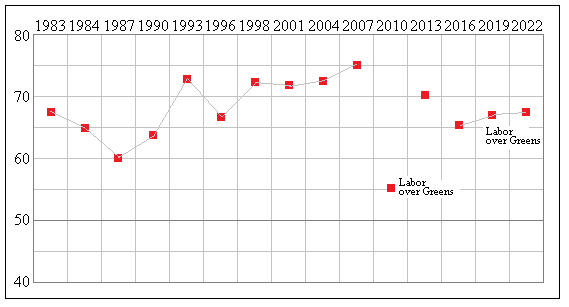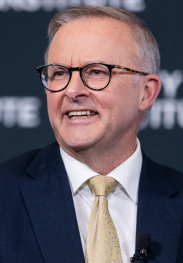|
|
|
|
| Adam Carr's Election Archive
|
Australian federal election, 2025
Division of Grayndler, New South Wales
Named for: Edward Grayndler (1867-1943), trade union leader, NSW MP
1921-43
Inner Sydney: Ashfield, Croydon Park, Leichhardt, Marrickville, PetershM
Enrolment at 2019 election: 109,567
Enrolment at 2022 election: 109,626 (+00.3)
1999 republic referendum: Yes 64.8
2018 same-sex marriage survey: Yes 79.9
2023 Voice referendum: Yes 74.6
 |
Sitting member: Hon Anthony Albanese (Labor): Elected 1996, 1998, 2001, 2004, 2007, 2010, 2013, 2016, 2019, 2022
Prime Minister
Leader of the Australian Labor Party
|
2007 Labor majority over Liberal: 24.9%
2010 Labor majority over Greens: 4.2%
2013 Labor majority over Liberal: 20.3%
2016 Labor majority over Greens: 15.8%
2019 Labor majority over Greens: 16.3%
2022 Labor majority over Greens: 17.1%
2025 notional Labor majority over Greens: 17.1%
Status 2022: Very safe Labor
Labor two-party vote 1983-2022

2022 results
Statistics and history
Announced candidates:
 |
 |
 |
Hon Anthony Albanese
Aust Labor Party |
David Smallbone
Liberal Party |
Hannah Thomas
Aust Greens |
Division of Grayndler
Grayndler was created in 1949, based in Sydney's inner western suburbs centred on Marrickville. Its boundaries have been
changed fairly radically several times since, but in 2010 they returned to something close to their original form. In the 1950s
these areas were still among the poorest parts of urban Australia, verging on being slums. Today this is one of the wealthiest
electorates in Australia, with a young population, a high proportion of graduates, more
than half the population working in professional and managerial occupations and a level of median family income in the top 20%.
Nearly 30% of residents were born in non English speaking countries.
What has not changed is the strength of the Labor vote, although much of it now comes in the form of preferences from the
Greens. In two-party terms, Grayndler is one of the safest Labor electorates in Australia, but the real threat to Labor comes
from the Greens, who now dominate this area at state level. They polled 22.0% of the vote here in 2019, to Labor's 53.7%.
The Greens came second in 2010, fell back to third in 2013, and came back to second in 2016, 2019 and 2022.
Past members for Grayndler include Labor veteran and minister
Fred Daly, minister
Jeannette McHugh and Speaker of the
House
Leo McLeay.
Anthony Albanese, Labor MP for Grayndler since 1996, was born in Sydney to an
Italian father and an Irish mother, and raised by his mother in public housing. He studied economics and worked for a union, joining the Left faction of the Labor Party. He worked for the veteran Left MP
Tom Uren, before becoming Assistant General Secretary of the NSW Labor Party in 1989.
In 1995 he became senior adviser to NSW Premier
Bob Carr, before entering Parliament in 1996. After serving as a senior minister throughout
the Rudd-Gillard Government, he was Deputy Prime Minister for three months before the 2013 election. Albanese is a leader of the
Labor Party's Left faction. After the 2013 election he was the Left's candidate for the leadership, but was defeated by
Bill Shorten.
After Labor's unexpected defeat in 2019, Shorten resigned and Albanese was elected unopposed to the leadership, becoming the
first Labor leader from the Left.* As leader he has inevitably proved a disappointment to the Left members who elected him. He
struggled to gain traction against the Morrison government, and in late 2020 there was serious talk of a leadership challenge from
the Right, although nothing came of this. During 2021 Morrison's accumulated failures in office played into Albanese's hands, and in May 2022 he led Labor to a narrow but clear election victory, becoming Prime Minister at 59.
Grayndler is always near the top of the Greens' target list, and the 2016 redistribution improved their position by adding the Greens stronghold of Balmain. But they failed to take advantage of this, partly because their socialist candidate in 2016 and 2019, Jim Casey, was too far
left even for Balmain. Albanese's prestige as Labor leader is probably sufficient to keep him safe from the Greens, although they could win the seat when he retires. The 2024 redistribution has moved Balmain back to the seat of Sydney, strengthening his position. The Liberal candidate is David Smallbone, a barrister.
*
Julia Gillard was a member of the Victorian Left when she was elected to Parliament in 1998, but by the time she became leader in 2010 she was no longer factionally aligned.
Back to main page
| |